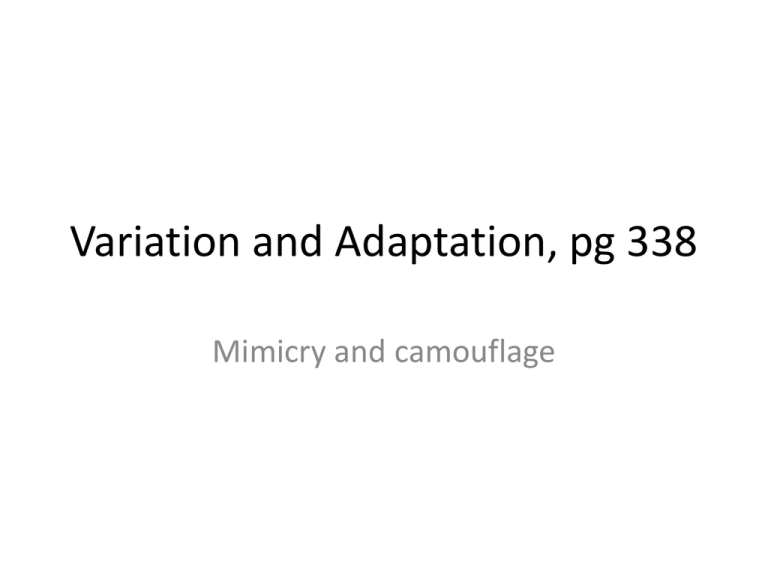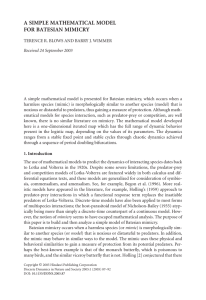camouflage and mimicry
advertisement

Variation and Adaptation, pg 338 Mimicry and camouflage Mimicry • When one animal copies the appearance, actions, or sounds of another animal, the first animal is called a mimic. You can think of it as a copycat! Usually, an animal will mimic another to avoid predators. If it can trick its enemy into thinking it is something less tasty or more dangerous, it will survive. Three forms of mimicry • Mimicry refers to the similarities between animal species. • There are three forms of mimicry utilized by both predator and prey: • Batesian mimicry, • Muellerian mimicry, and • self-mimicry. Monarch butterfly on the left, viceroy butterfly on the right. Both taste bad to predators • Batesian mimicry refers to two or more species that are similar in appearance, but only one of which is armed with spines, stingers, or toxic chemistry, while its apparent double lacks these traits. Batesian mimicry • The second species has no defense other than resembling the bad tasting species. This is an advantage since it gets protection from certain predators since it resembles the bad tasting species, which the predator associates with a certain appearance and a bad experience. Deadly coral snake "Red next to yellow, kill a fellow" Every other band is yellow and yellow touches both black and red, but black and red never touch. harmless king snake “Red against black: friend to Jack." Yellow does not touch red and every other band is not yellow. Black and red always touch. Can you guess which one is a sea slug and which is the flatworm mimic? • The sea slug gives off poisonous, smelly chemicals to discourage its predators. It exude very noxious and toxic chemicals from their skin and appear to be avoided by most fish. They are often the only sea slugs which blatantly crawl out in the open during the day. Why would the flatworm want to look like the sea slug? Bumblebees and Robber Flies • Two of these are Bumblebees (with stingers) and two are Robber Flies (which also make a sound similar to a bee). If you were a predator, could you "bee" sure of the difference? Yellow Banded Poison Frog • Muellerian mimicry • This form of mimicry refers to two unpalatable species that are mimics of each other with conspicuous warning coloration. Green and black poison dart frog • Thus all mimics share the benefits of the coloration since the predator will recognize the coloration of an unpalatable group after a few bad experiences. Blue poison dart frog • Since several species have the same appearance to the predator, the loss of life will be spread out over several species, reducing the impact on each individual species. Self mimicry • Self-mimicry is a misleading term for animals that have one body part that mimics another to increase survival during an attack or helps predators appear harmless. Owl butterfly • For example, countless moth, butterfly, and freshwater fish species have "eyespots"? Large dark markings that when flashed may momentarily startle a predator and allow the prey extra seconds to escape. "Eye-spots" also help prey escape predators by giving predators a false target. A butterfly has a better chance of surviving an attack to the outer part of its wing than an attack to the head. This jumping spider uses color and shape to mimic the ants that it hunts. • Some animals, like the octopus, can even change their color to match their environment. The octopus can also change the texture of its skin to look bumpy like the rocks where it is hiding. The walking stick and the skeleton shrimp also copy both the shapes and colors of the plants. You have to look closely to tell which are the branches and which are the animals. Self mimicry • One of the most interesting examples of self-mimicry is the so-called "two-headed" snake of Central Africa which has a tail that resembles a head and a head that resembles a tail. The snake even moves its tail in the way most snakes move their heads. This adaptation functions to trick prey into believing the attack is originating from where it is not. Another example, several turtle species and the Frogmouth Catfish (Chaca sp.) of Southeast Asia have tongue extensions that are used… … as a sort of lure to attract prey to a position where they become an easy catch. camouflage • An animal uses camouflage to blend in with its environment. Camouflage is the use of color, pattern, and shape to look like the things around you. • Predators, or hunters, will use camouflage to help them catch food. Prey, or the ones being hunted, will use camouflage to keep from being caught. Many animals use color to help them hide. Its yellow color helps this crab spider to hide while it hunts. • The polar bear's white fur keeps him hidden in the snow. Grasshoppers and lynx spiders use their green color to hide among the leaves and stems of plants. Crab spiders use color when they are hunting. See how the crab spider in the photo uses its yellow color to blend in while it waits for an insect to land. Katydid, a group of grasshopper like insects • Katydids have evolved to the point where their body coloring and shape matches leaves. Including half-eaten leaves, dying leaves, and leaves with bird droppings and also camouflage sticks, twigs, and tree bark. • Katydids are nocturnal insects which use their cryptic coloration to remain unnoticed during the day when they are inactive. They remain perfectly still, often in a position that makes them blend in even better. http://www.myinsectarium.com/ Walking stick insect Philly insect museum The gecko lizard is hard to see when he’s climbing a tree! Leaf moth Ruins moth Brookesia superciliaris Playing dead In leaf litter Leopard sleeping in a tree • Other forest species, especially mammals, have spots or stripes to help break up the animal's outline. jaguar • In the shade created by the canopy, large mammals like leopards, jaguars, ocelots, and okapi are surprisingly difficult to see with their disruptive coloration. ocelot Okapi, rare cousin of the giraffe • The Okapi is a primitive giraffe, about the size of a horse, found in a small region of rainforest in the Congo. It has striped legs like a zebra to help it blend into the shadows of the forest and a long neck to reach leaves above the floor. The Okapi is solitary or lives in pairs and feeds on foliage that is shunned by other forest creatures. The Okapi was only discovered by Western science in 1899 and less than 10,000 individuals exist today.








